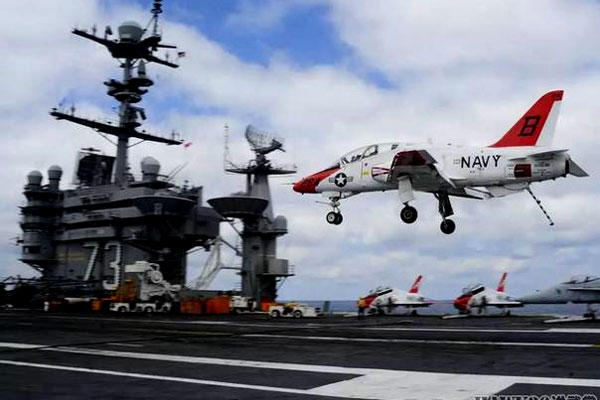The Navy has extended the operational pause implemented for its fleet of T-45C Goshawk trainer aircraft without a stated end date, to allow leadership to develop a plan to address hypoxia-like episodes in the cockpit.
Naval Air Forces officials first announced a three-day operational pause for the aircraft Wednesday, less than a day after Fox News reported that some 100 instructor pilots had refused to fly March 31, citing safety concerns.
Navy officials confirmed that about 40 percent of flights in T-45C training commands in Kingsville, Texas; Pensacola, Fla.; and Meridian, Miss., were canceled that day because of operational risk management issues raised by the pilots.
The decision to extend the grounding was announced Friday night, following a visit by Naval Air Forces Commander Vice Adm. Mike Shoemaker to all three training locations.
"We have the right team of [Naval Air Systems Command] program managers, engineers and maintenance experts in conjunction with type commander staffs, medical and physiological experts immersed in this effort working with the same sense of urgency to determine the root causes of [cockpit] physiological episodes," Shoemaker said in a statement.
"To tackle this as effectively as possible, we are using an 'unconstrained resources' approach to the problem, meaning we have not been nor will we be limited by money or manpower as we diligently work toward solutions," he said.
According to the announcement, naval aviation leadership will review engineering data during the extended operational pause to develop a plan to keep T-45 aircrews safe.
Cockpit problems are not new nor limited to the Goshawk -- Fox reported that cockpit episodes for the aircraft had quadrupled over the last five years. Even before the recent report came out, the Navy had been testing cockpit air quality, using Sorbent tubes, and had changed out sieve bed filters in the onboard oxygen generation systems to improve air quality.
The Navy now plans to require that Sorbent tubes be used on every flight "as soon as our inventory supports," according to Friday's release. Officials hope that this measure will ensure samples are captured from any physiological episode that might shed light on the possible contaminants.
The service also plans to refine aircrew procedures, improve maintenance practices to make existing systems more reliable, change inspection intervals to give maintainers a better chance to find parts that are failing, and buy and install cockpit pressurization warning systems, officials said.
"It was important for me to come talk with my aviation team members and hear their concerns as we work this challenging issue together," Shoemaker said in his statement. "We ask a lot of our pilots, and we owe it to them to ensure they understand we are doing everything we can to fix this problem, and that they have access to top leadership."
-- Hope Hodge Seck can be reached at hope.seck@military.com. Follow her on Twitter at@HopeSeck.
Related Video:




























